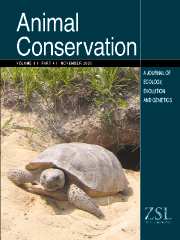Crossref Citations
This article has been cited by the following publications. This list is generated based on data provided by
Crossref.
Marsh, Helene
Lawler, Ivan R.
Kwan, Donna
Delean, Steve
Pollock, Kenneth
and
Alldredge, Matthew
2004.
Aerial surveys and the potential biological removal technique indicate that the Torres Strait dugong fishery is unsustainable.
Animal Conservation,
Vol. 7,
Issue. 4,
p.
435.
POLLOCK, KENNETH H.
MARSH, HELENE D.
LAWLER, IVAN R.
ALLDREDGE, MATHEW W.
and
Lubow
2006.
Estimating Animal Abundance in Heterogeneous Environments: An Application to Aerial Surveys for Dugongs.
Journal of Wildlife Management,
Vol. 70,
Issue. 1,
p.
255.
Holley, David K.
Lawler, Ivan R.
and
Gales, Nicholas J.
2006.
Summer survey of dugong distribution and abundance in Shark Bay reveals additional key habitat area.
Wildlife Research,
Vol. 33,
Issue. 3,
p.
243.
Drake, John M.
2006.
EXTINCTION TIMES IN EXPERIMENTAL POPULATIONS.
Ecology,
Vol. 87,
Issue. 9,
p.
2215.
Turvey, S.T
and
Risley, C.L
2006.
Modelling the extinction of Steller's sea cow.
Biology Letters,
Vol. 2,
Issue. 1,
p.
94.
Marsh, Helene
2007.
Fisheries Management.
p.
186.
Butler, James R.A.
Middlemas, Stuart J.
McKelvey, Simon A.
McMyn, Iain
Leyshon, Ben
Walker, Ian
Thompson, Paul M.
Boyd, Ian L.
Duck, Callan
Armstrong, John D.
Graham, Isla M.
and
Baxter, John M.
2008.
The Moray Firth Seal Management Plan: an adaptive framework for balancing the conservation of seals, salmon, fisheries and wildlife tourism in the UK.
Aquatic Conservation: Marine and Freshwater Ecosystems,
Vol. 18,
Issue. 6,
p.
1025.
McNiven, Ian J.
and
Bedingfield, Alice C.
2008.
Past and present marine mammal hunting rates and abundances: dugong (Dugong dugon) evidence from Dabangai Bone Mound, Torres Strait.
Journal of Archaeological Science,
Vol. 35,
Issue. 2,
p.
505.
Whiting, Scott D.
2008.
Movements and distribution of dugongs (Dugong dugon) in a macro-tidal environment in northern Australia.
Australian Journal of Zoology,
Vol. 56,
Issue. 4,
p.
215.
Sheppard, James K.
Carter, Alex B.
McKenzie, Len J.
Pitcher, C. Roland
and
Coles, Robert G.
2008.
Spatial patterns of sub-tidal seagrasses and their tissue nutrients in the Torres Strait, northern Australia: Implications for management.
Continental Shelf Research,
Vol. 28,
Issue. 16,
p.
2282.
Grech, A.
Marsh, H.
and
Coles, R.
2008.
A spatial assessment of the risk to a mobile marine mammal from bycatch.
Aquatic Conservation: Marine and Freshwater Ecosystems,
Vol. 18,
Issue. 7,
p.
1127.
Rasheed, Michael A.
Dew, Kara R.
McKenzie, Len J.
Coles, Robert G.
Kerville, Simon P.
and
Campbell, Stuart J.
2008.
Productivity, carbon assimilation and intra-annual change in tropical reef platform seagrass communities of the Torres Strait, north-eastern Australia.
Continental Shelf Research,
Vol. 28,
Issue. 16,
p.
2292.
Patterson, Brent R.
and
Murray, Dennis L.
2008.
Flawed population viability analysis can result in misleading population assessment: A case study for wolves in Algonquin park, Canada.
Biological Conservation,
Vol. 141,
Issue. 3,
p.
669.
Fordham, Damien A.
Georges, Arthur
and
Brook, Barry W.
2008.
Indigenous harvest, exotic pig predation and local persistence of a long‐lived vertebrate: managing a tropical freshwater turtle for sustainability and conservation.
Journal of Applied Ecology,
Vol. 45,
Issue. 1,
p.
52.
GRECH, A.
and
MARSH, H.
2008.
Rapid Assessment of Risks to a Mobile Marine Mammal in an Ecosystem‐Scale Marine Protected Area.
Conservation Biology,
Vol. 22,
Issue. 3,
p.
711.
Jones, A.
Barnett, B.
Williams, A.J.
Grayson, J.
Busilacchi, S.
Duckworth, A.
Evans-Illidge, E.
Begg, G.A.
and
Murchie, C.D.
2008.
Effective communication tools to engage Torres Strait Islanders in scientific research.
Continental Shelf Research,
Vol. 28,
Issue. 16,
p.
2350.
Marsh, Helene
and
Kwan, Donna
2008.
Temporal variability in the life history and reproductive biology of female dugongs in Torres Strait: The likely role of sea grass dieback.
Continental Shelf Research,
Vol. 28,
Issue. 16,
p.
2152.
Marsh, Helene
2009.
Encyclopedia of Marine Mammals.
p.
332.
Wilson, George R.
Edwards, Melanie J.
and
Smits, Jennifer K.
2010.
Support for Indigenous wildlife management in Australia to enable sustainable use.
Wildlife Research,
Vol. 37,
Issue. 3,
p.
255.
Dutta, Sutirtha
Rahmani, Asad R.
and
Jhala, Yadvendradev V.
2011.
Running out of time? The great Indian bustard Ardeotis nigriceps—status, viability, and conservation strategies.
European Journal of Wildlife Research,
Vol. 57,
Issue. 3,
p.
615.


